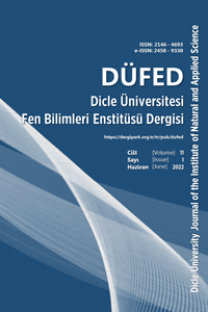Anilin temelli aminofosfinler ve katyonik bis fosfino amin Ru II kompleksleri: Ketonların transfer hidrojenasyonundaki katalitik aktiviteleri
Hidrojen transfer indirgenme reaksiyonu, ifllem kolaylığı avantajından dolayı sentez alanında çalıflankimyacıların ilgisini çekmektedir. Bu bağlamda, [Ru η-p-simen µ-Cl Cl]2 kompleksinden yola çıkarakNPP ve NHP ligandlarının bir dizi Ru II kompleksi sentezlendi ve bu kompleksler analitik ve spektroskopikmetotlarla tam olarak karakterize edildi. 1 - 4 kompleksleri hidrojen kaynağı olarak izopropil alkol varlığındabirçok alkil ve aril alkil ketonların sekonder alkollere transfer hidrojenasyonunu katalizlemektedir. Özellikle3 nolu kompleks mükemmel bir katalizör olarak davranmakta ve ilgili alkolleri % 99 a varan dönüflümlerlesağlamaktadır TOF:198 h-1
Aniline based aminophosphine and cationic bis phosphino amine Ru II complexes: Investigation of catalytic activity in transfer hydrogenation of ketones
Hydrogen transfer reduction processes are attracting increasing interest from synthetic chemists in viewof their operational simplicity. For this aim, a series of Ru II complexes with the NPP and NHP ligandswere synthesized starting from the complex [Ru η6-p-simen µ-Cl Cl]2. The complexes were fullycharacterized by analytical and spectroscopic methods. Complexes 1-4 catalyze the transfer hydrogenationof a variety of simple alkyl and aryl alkyl ketones to secondary alcohols in the presence of iso-PrOH as thehydrogen source. Notably 3 acts as an excellent catalyst giving the corresponding alcohols in excellentconversions up to 99% TOF:198 h-1
Keywords:
Aminophosphine Bis phosphino amine, Transfer hydrogenation, Ruthenium, Catalysis, Ketone,
___
1. S. Gladiali, G. Mestroni, Transition Metal for Organic Synthesis (Eds.: M. Beller. C. Bolm), Wiley-VCH, Weinheim 2 (1998) 97-119.2. H. Siegel. V. Himmele, Angew. Chem. Int. Ed. Engl. 92 (1980) 182-187.
3. C. Botteghi, S. Paganelli, A. Schionato, M. Marchetti, Chirality 3 (1991) 355-369.
4. H. Jiang, Q. D. Qiao, H. Gong, React. Kinet. Catal. Lett. 65 (1998) 193-197.
5. J. S. M. Samec, Jan-E. Backvall, Chem. Eur. J. 8 (2002) 2955-2961.
6. A. Del Zotto, W. Baratta, M. Ballico, E. Herdtweck, P. Rigo, Organometallics 26 (2007) 5636-5642.
7. K.G. Gaw, M.B. Smith, A.M.Z. Slawin, New J. Chem. 24 (2000) 429-435.
8. N. Biricik, F. Durap, B. Gumgum, Z. Fei, R. Scopelliti, Transition Met. Chem. 32 (7) (2007) 877- 883.
9. M. Aydemir, F. Durap, A. Baysal, O. Akba, B. Gumgum, S. Özkar, L.T. Yıldırım, Polyhedron 28 (2009) 2313-2320.
10. M. Necas, M.R.J. Foreman, J. Marek, J. D. Woollins, J. Novosad, New J. Chem. 25 (2001) 1256-1263.
11. M. Aydemir, A. Baysal, J. Organomet. Chem. 695 (2010) 2506-2511.
12. M. Aydemir, A. Baysal, Polyhedron 29 (2010) 1219- 1224.
13. M. S. Balakrishna, K. Ramaswarmy, R.M. Abhyankar, J. Organomet. Chem. 560 (1998) 131- 136.
14. A. M. Maj, K.M. Michal, I. Suisse, F. Agbossou, A. Mortreux, Tetrahedron: Asymmetry 10 (1999) 831- 835.
15. R. Le Lagadec, L. Rubio, L. Alexandrova, R. Toscano, E. V. Ivanova, R. Meskys, V. Laurinavicius, M. Pfeffer, A. D. Ryabov, J. Organomet. Chem. 689 (2004) 4820-4832.
16. A. D. Ryabov, V. S. Kurova, V. Ekaterina, R. Ivanova, R. Le Lagadec, L. Alexandrova, Anal. Chem. 77 (2005) 1132-1139.
17. M. Aydemir, A. Baysal, N. Meric, C. Kayan, B. Gümgüm, S. Özkar, E. Sahin, J. Organomet. Chem. 696 (2011) 2584-2588.
18. J. X. Gao, X. D. Yi, P. P. Xu, C. -L. Tang, H. L. Wan, T. Ikariya, J. Organometal. Chem. 592 (1999) 290-295.
19. J. X. Gao, H. Zhang, X. D. Yi, P. P. Xu, C. L. Tang, H. L. Wan, K. R. Tsai, T. Ikariya, Chirality 12 (2000) 383-388.
20. J.-S. Chen, Y.-Y. Li, Z.-R. Dong, B.-Z. Li, J.-X. Gao, Tetrahedron Lett. 45 (2004) 8415-8418.
21. M. A. Bennet, A. K. Smith, J. Chem. Soc. Dalton Trans. (1974) 233-241.
22. M. A. Bennet, T. N. Huang, T. W. Matheson, A. K. Smith, Inorg. Synth. 7 (1982) 74-78.
- ISSN: 2146-4693
- Yayın Aralığı: Yılda 2 Sayı
- Başlangıç: 2012
- Yayıncı: Dicle Üniversitesi
Sayıdaki Diğer Makaleler
Gülşah Saydan KANBEROĞLU, Raciye MERAL
Cezmi KAYAN, Nermin MERİÇ, Murat AYDEMİR, Akın BAYSAL, Hamdi TEMEL
NaCl -BaCl2 -H2O üçlü su-tuz sisteminin +50o'de incelenmesi
İhsan ALACABEY, Vedat ADIGÜZEL, Arzu YENİGÜN, Vedat TAVŞAN, Ali Rıza KUL, İhsan ALACABEY
Ahmet TOMBAK, Yusuf Selim OCAK, Tahsin KILIÇOĞLU
Hamdi TEMEL, Hasan UÇMAK, Salih PAŞA, Mustafa A. YILMAZ, Salih HOŞOĞLU
İki çekirdekli rutenyum II aren komplekslerinin ketonların transfer hidrojenasyonuna uygulanması
Nermin MERİÇ, Cezmi KAYAN, Murat AYDEMİR, Yusuf Selim OCAK, Akın BAYSAL, Hamdi TEMEL
Prevalence of house dust mites in houses, hotels and student dormitories of Diyarbakır province
